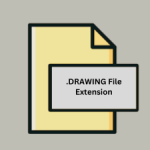.CVS File Extension

Canvas 3 Drawing File
| Developer | ACD Systems |
| Popularity | |
| Category | Vector Image Files |
| Format | .CVS |
| Cross Platform | Update Soon |
What is an CVS file?
The .CVS file format is primarily used for storing drawings and graphics created using Canvas 3 software.
Canvas 3 was renowned for its advanced graphics capabilities during its time and was widely used by graphic designers, illustrators, and artists.
More Information.
The introduction of .CVS files coincided with Canvas 3’s focus on vector-based drawing. These files were designed to efficiently store graphical elements such as shapes, lines, text, and images, leveraging vector graphics to ensure scalability without loss of quality.
Initially aimed at graphic designers, illustrators, and desktop publishers, Canvas 3 offered a user-friendly interface coupled with powerful drawing tools, making it a preferred choice for creating intricate illustrations and technical drawings.
Origin Of This File.
Canvas, initially developed by Deneba Systems in the late 1980s, gained prominence as a comprehensive graphics software suite.
The .CVS file extension became synonymous with Canvas 3, a version released during the early 1990s, which introduced advanced drawing capabilities and enhanced support for vector graphics.
Over subsequent versions, Canvas expanded its features to include photo editing, page layout, and presentation tools, cementing its position as a robust solution for creative professionals.
File Structure Technical Specification.
.CVS files adhere to specific technical specifications to ensure compatibility and functionality within the Canvas software ecosystem.
They typically comprise structured data that defines each graphical element within the drawing, including coordinates, colors, and other attributes.
Vector graphics stored in .CVS files are represented mathematically, allowing for precise rendering and editing without pixelation or loss of detail, a significant advantage over raster-based formats.
How to Convert the File?
Converting .CVS files to other formats may be necessary for compatibility with different applications or systems. Here are common conversion methods:
- Export to PDF: Canvas allows users to export .CVS drawings to PDF format, preserving vector quality for printing and sharing.
- Save as EPS: Encapsulated PostScript (EPS) format is widely supported and retains vector properties, ideal for professional printing and publishing.
- Convert to SVG: Scalable Vector Graphics (SVG) format is compatible with web browsers and various design applications, maintaining scalability and editability.
Advantages And Disadvantages.
Advantages:
- Scalability: Vector graphics ensure that .CVS files can be scaled to any size without loss of quality.
- Editability: Elements within .CVS files can be easily modified, rearranged, or enhanced using Canvas’s comprehensive editing tools.
- Compatibility: Canvas supports cross-platform compatibility, facilitating seamless collaboration and file sharing.
Disadvantages:
- Specialized Software: Viewing and editing .CVS files require ACD Systems’ Canvas software, which may not be universally available.
- File Size: Complex drawings stored as .CVS files can be large due to the inclusion of detailed vector data.
How to Open CVS?
Open In Windows
- Use Adobe Illustrator or CorelDRAW, which support importing ‘.CVS’ files. Alternatively, convert the file to a more common format like PDF or AI for broader compatibility.
Open In Linux
- Inkscape is a powerful open-source vector graphics editor that can handle ‘.CVS’ files. It supports a wide range of vector formats and is suitable for Linux users needing to work with Canvas 3 drawings.
Open In MAC
- Adobe Illustrator and Affinity Designer are popular choices for opening ‘.CVS’ files. Ensure the software supports legacy formats or convert the file to a more modern vector format if needed.













